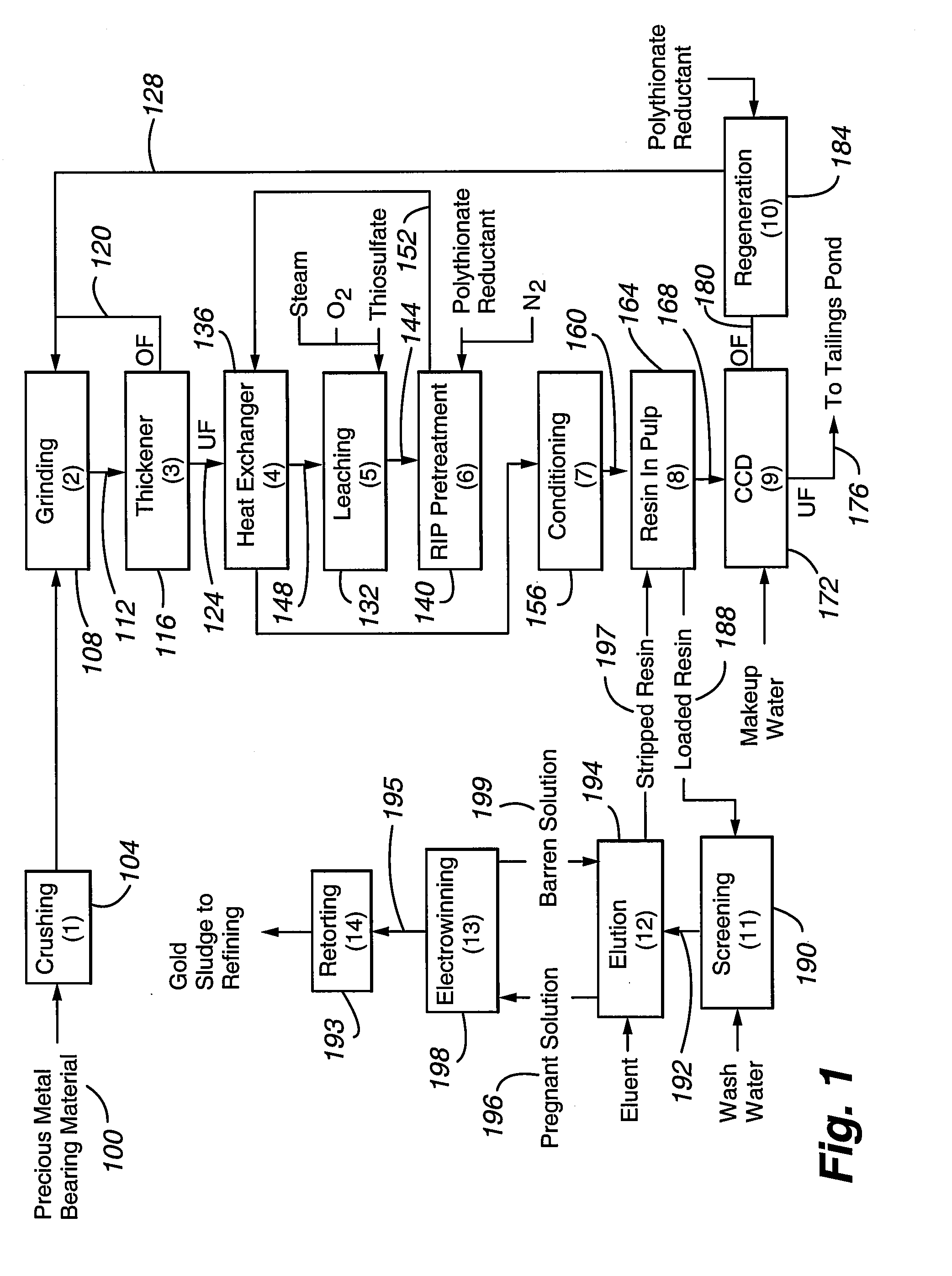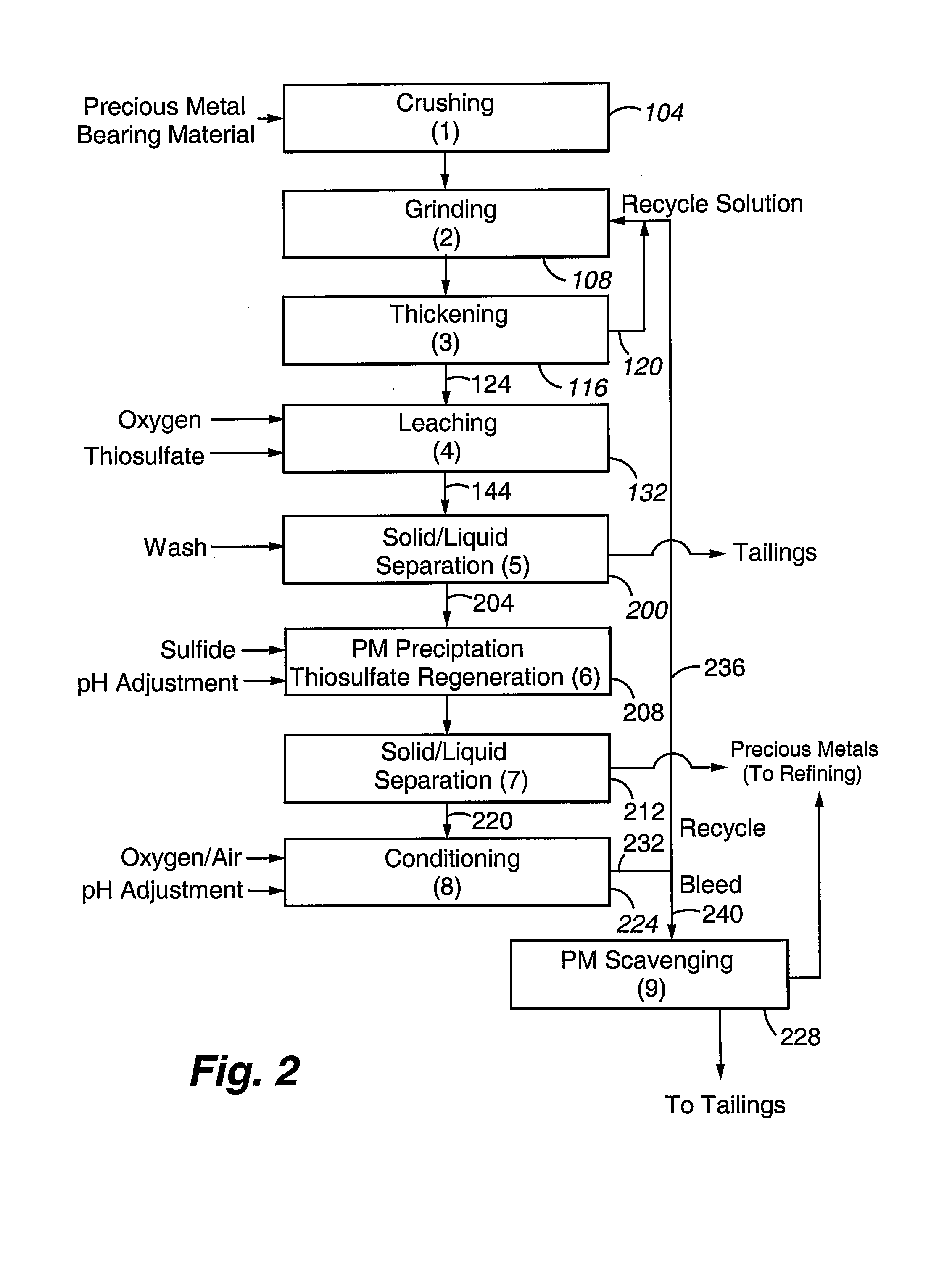Method for thiosulfate leaching of precious metal-containing materials
a precious metal and thiosulfate technology, applied in the field of recovery of precious metals from precious metalcontaining materials, can solve the problems of reducing precious metal reserves in many countries, severe limitations in the use of cyanide, and the cost of extracting precious metal(s) from ore, so as to improve the precious metal loading capacity of the resin
- Summary
- Abstract
- Description
- Claims
- Application Information
AI Technical Summary
Benefits of technology
Problems solved by technology
Method used
Image
Examples
example 1
[0098] A gold ore from Nevada, designated Sample A, was subjected to thiosulfate leaching under oxygen pressure at varying temperatures. The ore assayed 24.1 g / t gold, 2.59% iron, 0.31% total sulfur, 0.28% sulfide sulfur, 3.40% total carbon, 1.33% organic carbon and 0.02% graphitic carbon. From a diagnostic leaching analysis of the ore it was determined that a maximum of 83% of the contained gold was capable of being solubilized while the remaining gold was inaccessible to a lixiviant because it was encapsulated within pyrite and / or other minerals contained in the ore.
[0099] The ore was ground to 80% passing 200 mesh (75 μm). Samples of the ore were slurried with water to a pulp density of 33% solids in a mechanically agitated laboratory autoclave. The natural pH of the slurry at ambient temperature was 8.3. The pH of the slurry was adjusted to 9 with sodium hydroxide and a quantity of sodium thiosulfate reagent was added to adjust the initial leach solution thiosulfate concentrati...
example 2
[0102] A second gold ore from Nevada, designated Sample B, was subjected to thiosulfate leaching under oxygen pressure at varying initial pH's. The ore assayed 9.45 g / t gold, 2.50% iron, 0.39% total sulfur, 0.36% sulfide sulfur, 4.20% total carbon, 1.46% organic carbon and 0.05% graphitic carbon. From a diagnostic leaching analysis of the ore it was determined that 82% of the contained gold was capable of being solubilized. Samples of the ore were prepared and leached as described in Example 1, except the temperature was 60° C. in each test, the autoclave was pressurized with 50 psig oxygen, the initial pH was adjusted to either 9, 11 or 12, and the leach retention time was extended to 8 hours for the pH 11 and 12 tests.
[0103] The results were as follows:
Leach TimeCalc'd HeadResidueAu Ext'nInitial pH(hours)Au (g / t)Au (g / t)(%)9150.2262.4472.068.492.1075.311141.3263.0469.388.612.0076.81216.421.0413.688.613.3461.2
[0104] The results indicate that there was not much difference in gold...
example 3
[0105] A third gold ore sample from Nevada, Sample C, was subjected to thiosulfate leaching under oxygen pressure at varying temperatures. The head analysis of the ore was as follows:
Gold Ore Sample CAu,g / t9.50Fe, %2.52Cu, ppm40As, ppm647Hg, ppm14Ca, %9.0C (t), %4.45C (CO3), %3.12C (org), %1.38S (2-), %0.35S (t), %0.27Mg, %1.5
From a diagnostic leaching analysis of the ore it was determined that 83% of the contained gold was capable of being solubilized.
[0106] The ore was ground to 80% passing 200 mesh (75 μm). Samples of the ore were slurried with water to a pulp density of 33% solids in a mechanically agitated laboratory autoclave. The initial pH of the slurry was adjusted to approximately 11 with sodium hydroxide, after which the autoclave was sealed and pressurized to 100 psig oxygen with pure (95% plus) oxygen gas and the slurry was heated to the desired temperature. To initiate leaching, a quantity of sodium thiosulfate stock solution was injected to adjust the leach soluti...
PUM
 Login to View More
Login to View More Abstract
Description
Claims
Application Information
 Login to View More
Login to View More - R&D
- Intellectual Property
- Life Sciences
- Materials
- Tech Scout
- Unparalleled Data Quality
- Higher Quality Content
- 60% Fewer Hallucinations
Browse by: Latest US Patents, China's latest patents, Technical Efficacy Thesaurus, Application Domain, Technology Topic, Popular Technical Reports.
© 2025 PatSnap. All rights reserved.Legal|Privacy policy|Modern Slavery Act Transparency Statement|Sitemap|About US| Contact US: help@patsnap.com



